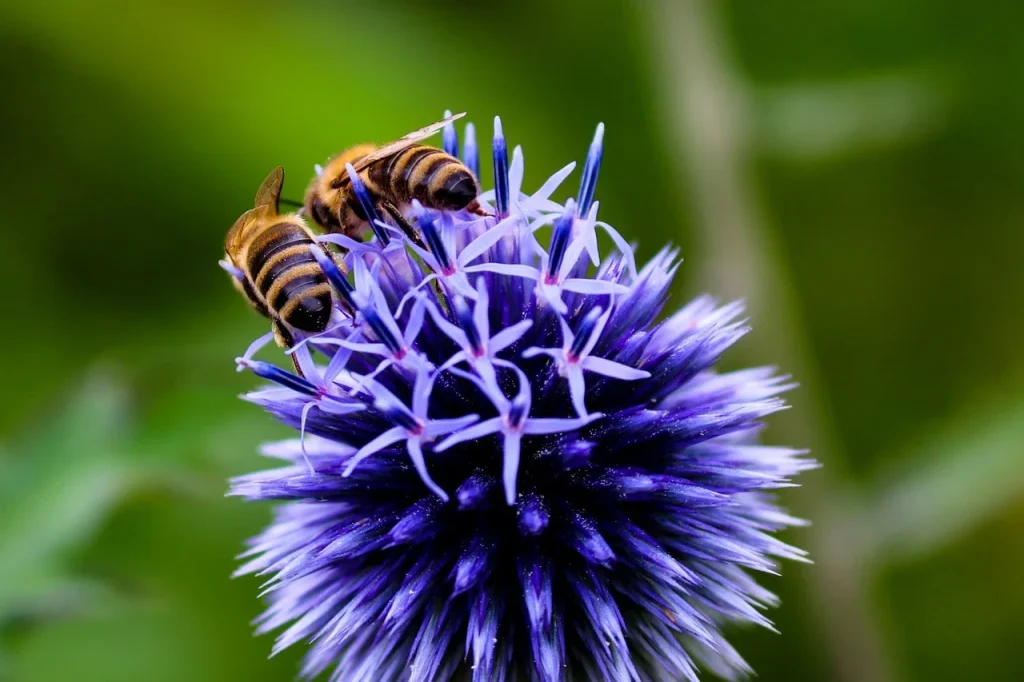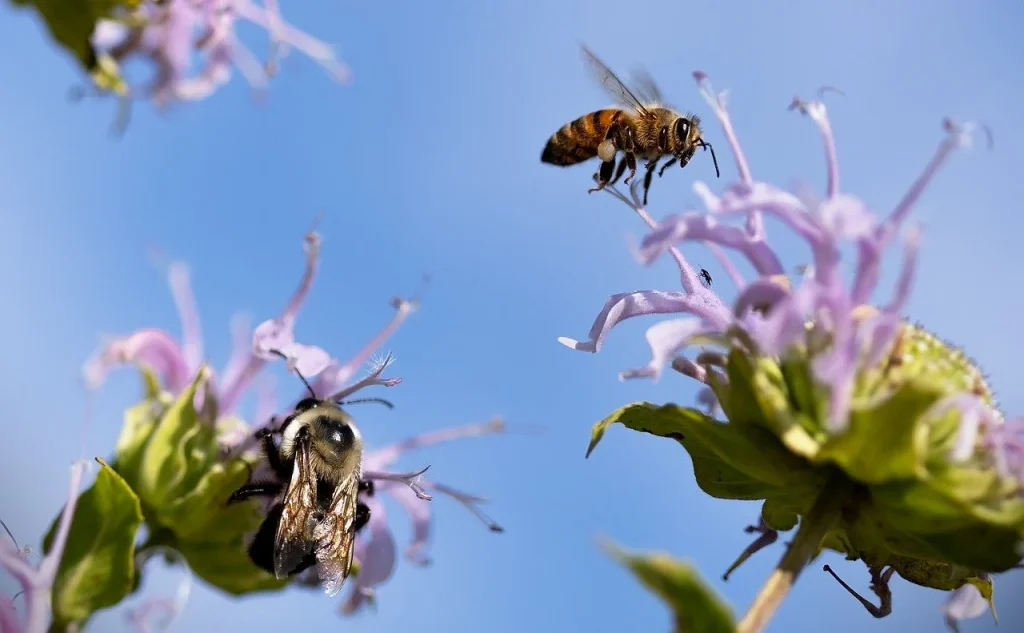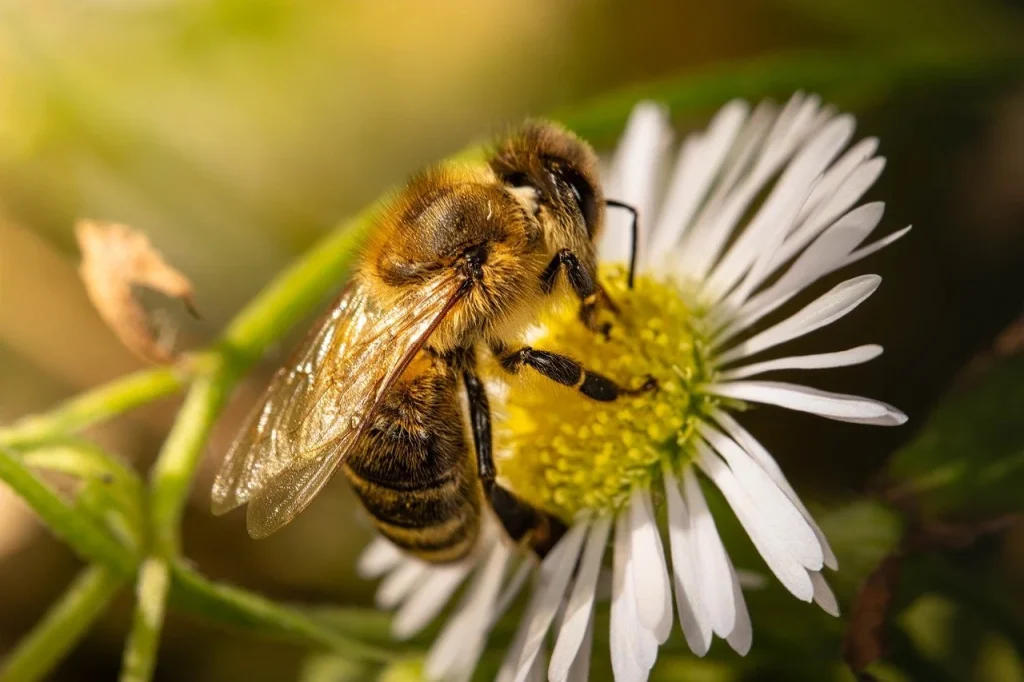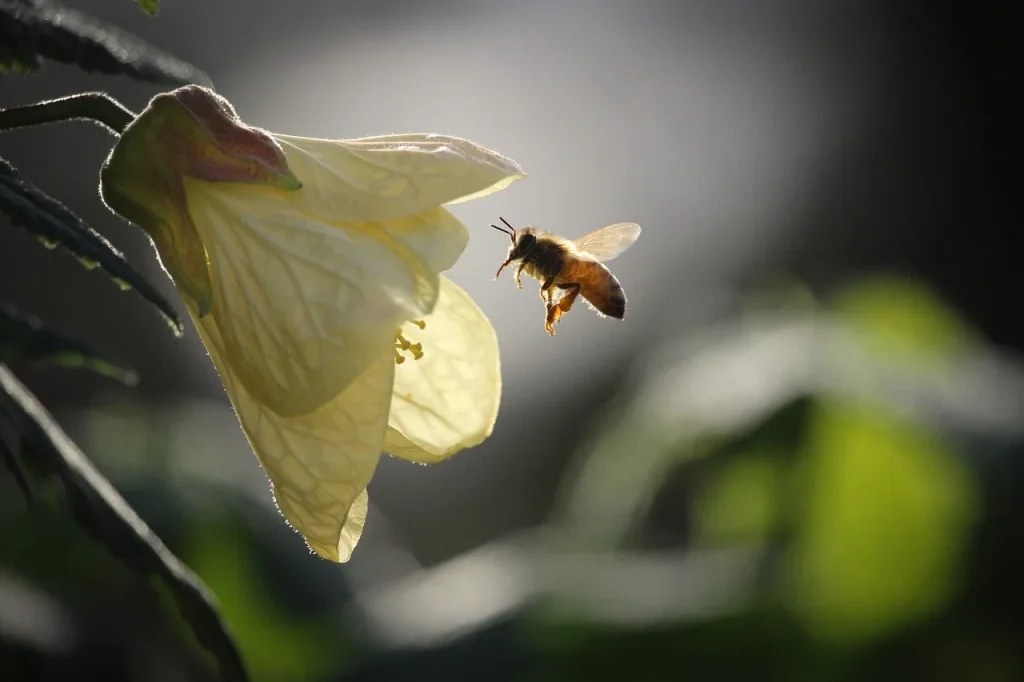Imagine a world without bees—our landscapes would be drastically different, and many foods we enjoy would disappear. Bees are not just fascinating; they are fundamental to sustaining life on Earth.
Today, let’s embark on a journey through some fun facts about these vital creatures, understanding their roles and why protecting them is crucial for our future.
The bee is more honored than other animals, not because she labors, but because she labors for others.
Saint John Chrysostom
Bees Facts
Before you explore the facts, remember there’s a quiz waiting at the bottom of this page. Read carefully to showcase your mastery on these incredible pollinators.
- These insects can recognize human faces using the same mechanism they use for processing flower shapes.
- Honey was found in King Tut’s tomb and, astonishingly, remained edible after 3,000 years.
- They can flap their wings about 200 times per second.
- When it’s too hot, bees form a ‘beard’ outside the hive to cool it down, engaging in a behavior known as bearding.
- These creatures can detect explosives with their finely-tuned sense of smell.
- Some species are capable of putting other insects into a temporary coma with a bite, a tool they use to protect their hive.
- The queen can live up to five years and is the only one in her colony who lays eggs.
- A single bee will produce only about 1/12 of a teaspoon of honey over its lifetime.
- Drones, the males of the colony, die immediately after mating.
- Vibrations are how these insects communicate, using movements known as the waggle dance to inform others about food location.
- Caffeine improves their long-term memory, which helps them remember where flowers are located.
- A colony can house up to 60,000 bees during the peak of a season.
- They can fly as far as five miles for food and return to the exact location of their hive.

- Their wings stroke incredibly fast, about 200 beats per second, creating their distinctive buzz.
- Propolis, a sticky substance used in the hive, has been used by humans for its medicinal properties.
- Worker bees are all females and do all the work for the hive.
- The queen’s only job is to lay eggs.
- When a new queen emerges, she embarks on a maiden flight to mate with about a dozen drones.
- Winter clusters maintain a steady 34°C to keep the queen warm.
- Their brain is oval in shape and about the size of a sesame seed.
- A hive’s location is communicated through a dance, which conveys both the distance and the direction to a food source.
- Blue and ultraviolet flowers attract these insects the most.
- They have hair on their eyes to help them collect pollen.
- Worker bees change jobs as they age, taking on tasks from cleaning to foraging as needed.
- Toxins in certain types of nectar can cause colonies to behave drunkenly.
- During winter, they consume up to 30 pounds of stored honey to produce heat.
- They are the only insect that produces food eaten by humans.
- Virgin queens emit pheromones which can cause drone bees to become attracted to them.

- Their sense of smell is so precise, they can differentiate hundreds of different floral varieties.
- They can estimate the passage of time from changes in light.
- Using their wings, they can create air currents to communicate with each other within their dark hive.
- Pollination helps to produce about one-third of the food that humans consume.
- Sterile female workers will police the hive, removing eggs laid by other workers.
- Only female bees have stingers, which are modified egg-laying organs.
- The speed of a bee can reach up to 15 miles per hour.
- Hygiene is important in the hive; workers will carry dead and debris far from their home to avoid disease.
- Their brains defy their small size; capable of complex calculations on distances and efficiency.
- Sting venom has properties that can act as a natural painkiller, which is why some traditional medicine practices use bee stings for therapy.

- When necessary, they can adapt by cross-pollinating in areas where specific flowers are scarce.
- Their color vision is optimized for detecting flowers, with the ability to see ultraviolet light.
- Several species sleep between five and eight hours a day, mostly at night.
- Hives are perennial structures and can be used by swarms of bees for many years.
- They practice “altruistic suicide” when sick, leaving the hive to die away from the colony to avoid infecting others.
- Extreme weather conditions can cause them to cease foraging and focus entirely on protecting the queen.
- Wax produced by worker bees is used to construct the hexagonal cells of the honeycomb.
- A strong sense of time helps them keep track of the availability of flowering plants.
- Navigational skills in these creatures are highly developed, allowing them to return to their hives from distances up to five miles away.
- They are among the few animals that can communicate distance and direction relative to the sun’s position.
- They can maintain a constant temperature in the hive through collective work, a feat essential for their survival and honey production.
- Some species can “shimmer” in response to a threat, causing waves of coordinated movement that disorient predators.
Bees Myths

Now that we’ve explored the facts about bees, let’s clear up some common misconceptions. In the next section, we’ll separate the myths from the truth.
- Bees are aggressive and will sting without provocation.
Generally, they are not aggressive and only sting as a defense mechanism. When threatened or when their hive is disturbed, stinging is resorted to. Otherwise, bees are more interested in pollinating plants and producing honey. - All bees make honey.
Honey is only produced by honeybees. Among the thousands of bee species, most do not make honey. Pollination is the primary activity engaged in by many bee species, which benefits ecosystems significantly. - Bees can only sting once before they die.
It is only the honeybee that dies after stinging, as their stinger is left in the skin. Multiple stings can be delivered by other species, such as bumblebees, without the loss of their lives. - Bees are solitary creatures.
While some species of bees are solitary, many others, like honeybees and bumblebees, live in highly organized societies. In these colonies, tasks are divided and communal living is embraced. - Bees are only found in warm climates.
They are found across diverse climates and continents, adapting to a wide range of environmental conditions. Even in colder regions, certain species have evolved to survive and thrive.
Bees Quotes

We continue with some quotes. If you BEE-lieve you have more, just send them in the comments and I will add them to the list.
The keeping of bees is like the direction of sunbeams.
Henry David Thoreau
Henry David Thoreau likened beekeeping to harnessing nature’s energy, emphasizing the natural and harmonious interaction between humans and bees.
The bee’s life is like a magic well: the more you draw from it, the more it fills with water.
Karl Von Frisch
Karl Von Frisch observed the industrious nature of bees, suggesting that their productivity and benefits are limitless, much like a replenishing well.
If the bee disappeared off the face of the Earth, man would only have four years left to live.
Misattributed to Albert Einstein
This quote, often misattributed to Albert Einstein, underscores the critical ecological role bees play in pollinating the plants that we rely on for food.
One can no more approach people without love than one can approach bees without care. Such is the quality of bees.
Leo Tolstoy
Leo Tolstoy drew a parallel between the care needed in handling bees and the love required to engage with people, emphasizing gentleness and respect.
Bees do have a smell, you know, and if they don’t they should, for their feet are dusted with spices from a million flowers.
Ray Bradbury
Ray Bradbury poetically noted the aromatic and sensory richness of bees, which carry the essences of countless flowers they visit.
Bees FAQ

As we transition to the FAQ section, remember these questions are your final nuggets of knowledge before the quiz. Read carefully to ensure you’re fully prepared!
- Will bees sting for no reason?
No, they generally do not sting without a reason. They might sting if they feel threatened or if their hive is in danger. It’s their way of defending themselves or their colony. - Can bees smell fear?
They can’t smell fear, but they can detect rapid movements and the carbon dioxide you exhale, which might be more pronounced when you’re scared. These signals can make bees more alert or defensive. - Will bees swarm without a queen?
No, they typically do not swarm without a queen. Swarming is a natural part of their reproductive cycle, where the queen leaves the colony with a large group of worker bees to form a new colony. - Can bees fly at night?
Most bees are not nocturnal and prefer to fly during the day. However, some species, like certain types of sweat bees, can fly at dusk or dawn, and very few might be active at night. - Are bees endangered?
Some species of bees are indeed endangered or at risk due to factors like habitat loss, pesticide use, and climate change. Conservation efforts are crucial to protect these vital pollinators and their ecosystems.
Bees Trivia

Welcome to the ultimate bee quiz! If you don’t get any questions right, brace yourself to be ‘pollen’-ted by bee puns for the rest of the day!
Conclusion
As we’ve learned, bees are not just fascinating; they’re essential to the survival of many ecosystems. They help plants grow, breed, and produce food.
Without them, our gardens would be less vibrant and our plates less colorful. So next time you enjoy a piece of fruit, thank a bee. Till next time, stay curious and explore more. Cheers.
2 Sources Used For This Article

